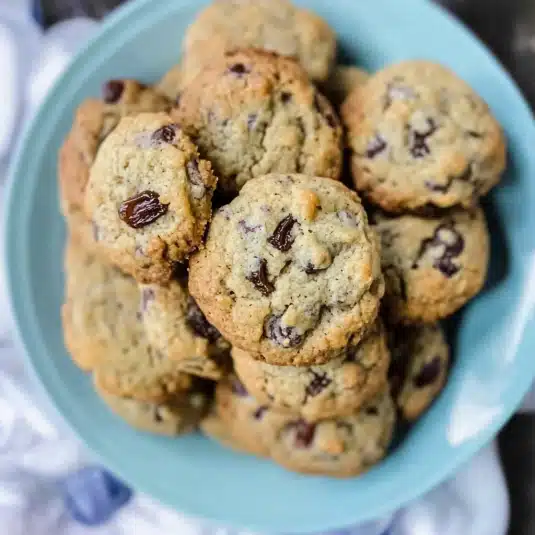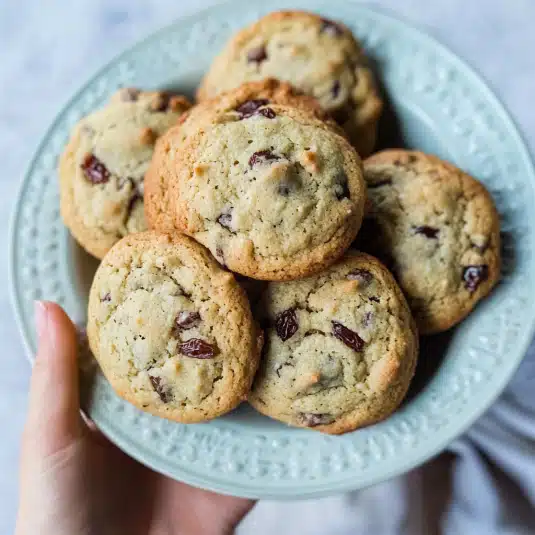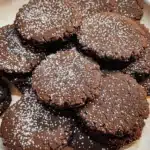Date cookies are more than just a sweet bite—they’re a delicious fusion of natural fruit sweetness and soft, buttery texture. Whether you enjoy them as an afternoon snack, a holiday treat, or a healthy dessert alternative, date cookies have a unique flavor that stands out among other baked goods. In this guide, we’ll dive deep into their origins, health benefits, step-by-step recipes, storage tips, and creative serving ideas. You’ll also learn how to choose the best ingredients, avoid common baking mistakes, and answer some of the most frequently asked questions about date cookies.
Looking for more cookie inspiration? Check out our peanut butter cup cookies recipe for another indulgent yet easy-to-make treat.

Table of Contents
Introduction to Date Cookies
The Unique Appeal of Date Cookies
Date cookies combine the chewiness of dried dates with the crisp or soft texture of a cookie base, making them a treat that satisfies both texture lovers and those who prefer natural sweetness. Dates have a rich, caramel-like taste, so you don’t need to rely heavily on refined sugar to achieve delicious results. This makes date cookies a great option for people who want to enjoy dessert while cutting down on processed sweeteners.
Bakers often appreciate how versatile dates are—they can be chopped into chunks for texture, pureed for a smooth filling, or rolled into dough for evenly distributed sweetness. This adaptability allows date cookies to fit a variety of dietary preferences, from vegan to gluten-free.

Date Cookies
- Total Time: 27 minutes
- Yield: 12 cookies 1x
- Diet: Vegetarian
Description
Date cookies are soft, chewy, and naturally sweet treats made with chopped dates, warm spices, and wholesome ingredients. Perfect for a healthy dessert or snack, they blend old-world charm with modern baking simplicity.
Ingredients
- 1 cup chopped softened dates (or date paste)
- ½ cup butter or coconut oil
- ½ cup brown sugar or coconut sugar
- 1 large egg (or flax egg for vegan)
- 1 cup all-purpose or almond flour
- ½ tsp baking soda
- 1 tsp vanilla extract
- Pinch of cinnamon and salt
Instructions
- Preheat the oven to 350°F (175°C).
- In a mixing bowl, cream the butter and sugar until light and fluffy.
- Add the egg and vanilla, mixing until well incorporated.
- In another bowl, combine the flour, baking soda, cinnamon, and salt, whisking them together.
- Gently fold the dry ingredients into the wet mixture, then mix in the chopped dates.
- Scoop dough balls onto a parchment-lined baking sheet, spacing them about 2 inches apart.
- Bake for 10 to 12 minutes, or until the edges turn golden brown.
- Let the cookies cool on the baking sheet for 5 minutes, then transfer them to a wire rack to cool completely.
Notes
For best texture, always soften your dates before using. You can soak them in hot water, almond milk, or coffee for added flavor. Avoid overbaking to keep the cookies soft and chewy.
- Prep Time: 15 minutes
- Cook Time: 12 minutes
- Category: Dessert
- Method: Baking
- Cuisine: Middle Eastern-American
Nutrition
- Serving Size: 1 cookie
- Calories: 140
- Sugar: 10g
- Sodium: 60mg
- Fat: 7g
- Saturated Fat: 3g
- Unsaturated Fat: 4g
- Trans Fat: 0g
- Carbohydrates: 18g
- Fiber: 1.5g
- Protein: 2g
- Cholesterol: 15mg
Why Date Cookies Are Gaining Popularity in the USA
In recent years, date cookies have become a trendy choice among home bakers and artisan bakeries across the USA. Health-conscious consumers love them for their nutrient profile, while foodies appreciate their deep, earthy sweetness.
Social media platforms have helped spread the love for date cookies, with viral baking videos showcasing creative twists—like date-stuffed thumbprints, oat-and-date sandwich cookies, and even chocolate-dipped versions. The rise in interest also ties to the growing demand for better-for-you desserts that blend indulgence with nutritional value.

The History of Date Cookies
Origins and Cultural Significance
Date cookies trace their roots back to ancient civilizations in the Middle East and North Africa, where dates were a staple food and a symbol of hospitality. Historically, dates were prized not only for their long shelf life but also for their natural sweetness, which made them ideal for desserts before refined sugar became common.
The earliest versions of date-filled pastries—such as the famous Middle Eastern ma’amoul—featured crumbly dough wrapped around a soft date paste. These treats were often served during religious celebrations like Ramadan and Eid, symbolizing generosity and joy.
As trade routes expanded, dates traveled with merchants across Asia, Europe, and eventually the Americas. This exchange introduced new baking methods and ingredients, leading to variations of date cookies that combined local flours, spices, and fats.
How Date Cookies Evolved Over Time
When dates reached Europe and later North America, they became a popular baking ingredient during the 19th and early 20th centuries—especially in regions where imported fruits were a luxury. Early American cookbooks often included recipes for date bars, drop cookies, and filled cookies, catering to families looking for affordable yet flavorful treats.
In modern baking, date cookies have evolved from simple homestyle snacks to gourmet creations. Today’s bakers experiment with ingredients like almond flour, coconut sugar, and dark chocolate, elevating date cookies into an artisanal dessert.
For another taste of dessert history, discover our red velvet crinkle cookies and see how a classic has transformed over time.
Health Benefits of Date Cookies

Nutritional Profile of Dates
Dates are a powerhouse of nutrients, making them more than just a natural sweetener. They’re rich in dietary fiber, potassium, magnesium, and antioxidants like flavonoids and carotenoids. This nutrient profile supports digestive health, helps regulate blood pressure, and may even reduce inflammation.
Dates are particularly notable for their natural sugar content, primarily glucose and fructose, offering a quick energy boost without the energy slump commonly linked to refined sugars.
When incorporated into cookies, dates allow bakers to reduce or even eliminate the need for processed sugar. This makes date cookies a better option for those aiming for healthier dessert choices.
| Nutrient | Amount per 100g of Dates | Benefit |
|---|---|---|
| Fiber | 6.7g | Supports digestion and satiety |
| Potassium | 696mg | Helps maintain healthy blood pressure |
| Magnesium | 54mg | Supports muscle and nerve function |
| Antioxidants | High | Reduces oxidative stress |
Are Date Cookies Good for You?
Yes—when made with wholesome ingredients, date cookies can be a nutritious treat. Unlike traditional cookies loaded with refined sugar and empty calories, date cookies offer natural sweetness paired with fiber and minerals. This blend helps slow the absorption of sugar, avoiding rapid spikes in blood sugar levels.
Of course, moderation matters. While dates are healthier than white sugar, they’re still calorie-dense. Pairing them with whole-grain flours, nuts, or seeds can boost their nutritional value even further.
Health-conscious bakers often swap butter for coconut oil or nut butters and use oats or almond flour instead of refined white flour. These adjustments not only enhance the cookie’s health profile but also add new textures and flavors.
If you’re looking for another naturally sweet dessert, check out our 3-ingredient oatmeal cookies for a quick and wholesome option.
Ingredients & Variations
Essential Ingredients for Classic Date Cookies
At their core, classic date cookies require just a handful of pantry staples. These include:
- Chopped or pureed dates – the primary sweetener and texture booster
- Butter or coconut oil – for richness and softness
- All-purpose flour – provides the structural base
- Brown sugar or coconut sugar – optional for added depth
- Eggs – bind the dough together
- Vanilla extract and spices (cinnamon, nutmeg) – enhance the cookie’s warm flavor
Depending on the recipe, dates can be mixed directly into the dough, used as a filling, or blended into a thick paste. Many bakers love the versatility that dates offer—they work just as well in soft and chewy cookies as they do in crisp ones.
Here’s a sample table of common ingredients with possible healthy substitutions:
| Standard Ingredient | Healthy Alternative |
|---|---|
| White flour | Almond flour, oat flour |
| Brown sugar | Coconut sugar, maple syrup |
| Butter | Avocado oil, nut butter |
| Eggs | Chia or flaxseed “eggs” |
Popular Variations: Gluten-Free, Vegan, and Nut-Filled Options
Modern bakers have reinvented date cookies to suit various dietary needs. Gluten-free versions often use almond or oat flour, giving the cookie a nutty flavor and dense texture. For a vegan twist, eggs can be swapped with mashed bananas or flax eggs, while plant-based butter or coconut oil replaces dairy.
Nut-stuffed date cookies are also gaining traction—think chopped walnuts or pecans mixed into the dough or whole almonds tucked inside date-filled centers. These variations not only add crunch but also introduce healthy fats and extra nutrients.
Other creative spins include:
- Date thumbprint cookies with fruit jam centers
- Chocolate-dipped date cookies for a decadent finish
- Spiced oat and date cookies for a hearty snack
Want something more adventurous? Don’t miss our tiramisu cookies, a fusion dessert that shows how far cookie creativity can go.
Step-by-Step Guide to Making Date Cookies
Preparing the Dates: How to Soften Dates for Biscuits
Dates can be sticky and firm, which is why softening them is key for smooth blending and better cookie texture. To do this, simply:
- Remove pits from the dates if they’re not already pitted.
- Soak in hot water for 10–15 minutes until they plump up.
- Drain well to avoid adding excess moisture to the dough.
- Mash or puree using a food processor for a paste-like consistency.
For a flavor boost, you can soak dates in warm milk, almond milk, or even brewed coffee instead of plain water. This infuses the fruit with subtle notes that elevate your cookies.
Mixing, Baking, and Cooling for Perfect Results
Here’s a straightforward method to make a batch of classic chewy date cookies:
Ingredients:
- 1 cup chopped softened dates (or date paste)
- ½ cup butter or coconut oil
- ½ cup brown sugar or coconut sugar
- 1 large egg (or flax egg for vegan)
- 1 cup all-purpose or almond flour
- ½ tsp baking soda
- 1 tsp vanilla extract
- Pinch of cinnamon and salt
Instructions:
- Preheat the oven to 350°F (175°C).
- In a mixing bowl, cream the butter and sugar until light and fluffy.
- Add the egg and vanilla, mixing until well incorporated.
- In another bowl, combine the flour, baking soda, cinnamon, and salt, whisking them together.
- Gently fold the dry ingredients into the wet mixture, then mix in the chopped dates.
- Scoop dough balls onto a parchment-lined baking sheet, spacing them about 2 inches apart.
- Bake for 10 to 12 minutes, or until the edges turn golden brown.
- Let the cookies cool on the baking sheet for 5 minutes, then transfer them to a wire rack to cool completely.
For best results, avoid overbaking—date cookies should be slightly soft in the center to preserve their chewiness.
If you enjoy experimenting with flavors, you might like our honey cookies for another naturally sweet treat.
Storage, Shelf Life & Safety
How to Store Date Cookies for Maximum Freshness
Proper storage is key to maintaining the flavor and texture of your date cookies. Since dates have natural sugars that help retain moisture, these cookies tend to stay soft longer than traditional ones.
Best practices for storage:
- Room temperature: Keep in an airtight container for up to 5–7 days.
- Refrigeration: Extends freshness to about 2–3 weeks. Ideal for soft, chewy varieties.
- Freezing: Store in a freezer-safe bag or container for up to 3 months. Thaw at room temperature before serving.
If freezing, consider separating layers with parchment paper to prevent cookies from sticking together.
Is It Safe to Eat Cookies After the Expiration Date?
This depends on how the cookies were stored and whether they show signs of spoilage. Commercially packaged cookies have a “best by” date, which indicates peak quality—not necessarily the exact spoilage date. If your date cookies were stored properly and show no mold, off smells, or strange textures, they may still be safe to eat a few days past their date.
However, for homemade date cookies, it’s best to follow these rules:
- Check appearance: Discard if there’s visible mold or discoloration.
- Smell test: A sour or rancid odor means they’re no longer safe.
- Taste cautiously: If in doubt, throw them out—food safety should always come first.
For more dessert storage tips, discover our chocolate shortbread cookies which also benefit from proper storage methods.
Pairings & Serving Ideas
Best Beverages to Enjoy with Date Cookies
The deep, caramel-like sweetness of dates pairs beautifully with a variety of drinks, making date cookies a versatile treat for any time of day. Here are some delicious combinations:
- Coffee or espresso – The bitterness balances the natural sweetness of the cookies.
- Chai tea – Spiced notes enhance the warmth of cinnamon or nutmeg in your recipe.
- Mint tea – Provides a refreshing contrast to the rich, chewy texture.
- Warm milk or almond milk – A comforting choice for kids and adults alike.
- Dessert wines – For a more indulgent pairing, try a sweet port or sherry.
If you’re hosting a brunch, a plate of date cookies next to a coffee bar can be an instant crowd-pleaser.
Creative Plating Ideas for Gatherings
Date cookies can be presented in ways that elevate their appeal, whether you’re hosting a dinner party or preparing holiday platters:
- Cookie towers – Stack different varieties (plain, nut-stuffed, chocolate-dipped) for visual interest.
- Themed platters – Pair date cookies with other Middle Eastern treats like baklava for cultural flair.
- Mini dessert jars – Layer crumbled date cookies with yogurt or cream for an easy parfait.
- Gift bags – Wrap 4–6 cookies in clear cellophane with a ribbon for a homemade gift.
For a festive presentation idea, you can take inspiration from our raspberry cheesecake cookies which look as good as they taste.
Common Mistakes & How to Avoid Them
Overbaking or Underbaking Issues
One of the most common pitfalls when making date cookies is overbaking. Since dates naturally caramelize, the cookies can appear done before they’re actually baked through, or they can burn easily if left too long in the oven.
Solution: Keep a close eye during the last 2–3 minutes of baking. Remove the cookies when the edges are golden brown, even if the center looks slightly soft—it will firm up as it cools.
Underbaking, on the other hand, can result in cookies that collapse or feel gummy in the center. This usually happens when the dough is too wet or the oven temperature is too low.
Balancing Sweetness and Texture
Dates are naturally very sweet, so adding too much extra sugar can make cookies overwhelmingly rich.
Solution: Reduce added sugar by 25–50% compared to a traditional cookie recipe. If you’re adding other sweet ingredients, such as chocolate chips or sweetened coconut, adjust accordingly.
Texture balance is also crucial—too much date paste can make cookies overly soft and sticky, while too little can make them dry. Adding chopped nuts, oats, or seeds can help provide structure and contrast.
Another tip: Always soften and chop dates evenly to avoid dense pockets in the dough.
For more ideas on enhancing cookie texture, explore our condensed milk cookies which also balance moisture and sweetness beautifully.
FAQs
What is the history of cookies?
Cookies date back to 7th century Persia, one of the first regions to cultivate sugar. They spread to Europe through the Muslim conquest of Spain and became a popular treat across the continent. By the 17th century, cookies had reached America with Dutch settlers. Early recipes were simple—often sugar, butter, flour, and eggs—but evolved into countless variations, including date cookies, which blend Old World techniques with Middle Eastern ingredients.
How to soften dates for biscuits?
Remove pits and soak the dates in hot water for 10–15 minutes, then drain and mash or puree. For extra flavor, soak in warm milk, almond milk, or coffee. This makes the dates easier to mix into dough and ensures an even texture.
Conclusion
Date cookies are the perfect blend of tradition, flavor, and nutrition. From their ancient origins in Middle Eastern kitchens to their modern reinvention in health-conscious American bakeries, these cookies have stood the test of time. Whether you’re looking for a naturally sweet dessert, a wholesome snack, or a unique addition to your holiday baking list, date cookies deliver on taste and versatility. With endless variations—from nut-filled treats to chocolate-dipped delights—there’s a recipe to suit every palate.
If you haven’t tried baking them yet, now is the perfect time. With the right ingredients, proper technique, and a dash of creativity, your kitchen could become home to the best date cookies you’ve ever tasted. Don’t miss our triple chocolate cookies if you want another rich dessert to add to your collection.
Fore more recipes follow me in Facebook, medium and Pinterest




